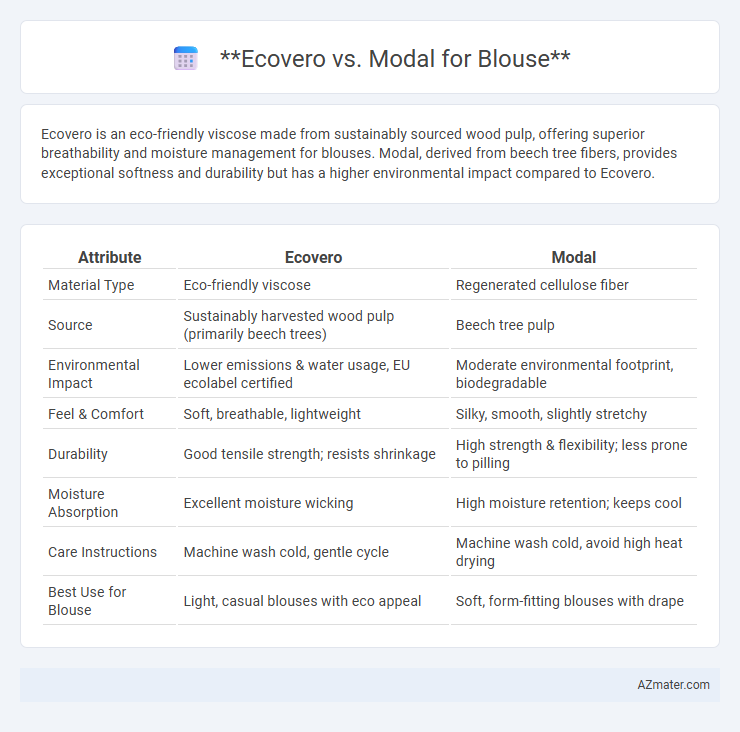Ecovero is an eco-friendly viscose made from sustainably sourced wood pulp, offering superior breathability and moisture management for blouses. Modal, derived from beech tree fibers, provides exceptional softness and durability but has a higher environmental impact compared to Ecovero.
Table of Comparison
| Attribute | Ecovero | Modal |
|---|---|---|
| Material Type | Eco-friendly viscose | Regenerated cellulose fiber |
| Source | Sustainably harvested wood pulp (primarily beech trees) | Beech tree pulp |
| Environmental Impact | Lower emissions & water usage, EU ecolabel certified | Moderate environmental footprint, biodegradable |
| Feel & Comfort | Soft, breathable, lightweight | Silky, smooth, slightly stretchy |
| Durability | Good tensile strength; resists shrinkage | High strength & flexibility; less prone to pilling |
| Moisture Absorption | Excellent moisture wicking | High moisture retention; keeps cool |
| Care Instructions | Machine wash cold, gentle cycle | Machine wash cold, avoid high heat drying |
| Best Use for Blouse | Light, casual blouses with eco appeal | Soft, form-fitting blouses with drape |
Introduction to EcoVero and Modal Fabrics
EcoVero is a sustainable fabric made from certified renewable wood sources, offering a lower environmental impact through reduced water consumption and emissions during production. Modal, derived from beech tree pulp, is known for its softness, breathability, and biodegradability, making it a preferred choice for comfortable blouse fabrics. Both EcoVero and Modal provide eco-friendly alternatives to conventional textiles, with EcoVero emphasizing certified sustainability and Modal highlighting natural fiber qualities.
Origins and Production Processes
Ecovero and Modal both originate from sustainable raw materials but differ in source and production methods; Ecovero is derived from certified sustainable wood pulp, processed under environmentally responsible conditions to minimize emissions and water use. Modal is produced from beech tree cellulose through a closed-loop process that reuses chemicals and water, emphasizing biodegradability and reduced environmental impact. Both fibers offer eco-friendly alternatives for blouse fabrics, with Ecovero highlighting forest stewardship certifications and Modal focusing on efficient, low-impact manufacturing.
Environmental Impact Comparison
Ecovero fibers are derived from certified sustainably managed wood sources and use 50% less water and 50% lower emissions in production compared to conventional viscose, making them a more environmentally friendly choice for blouses. Modal, particularly when sourced from beech trees, offers good biodegradability and a soft texture but often involves higher chemical use and water consumption in processing. Choosing Ecovero over conventional modal reduces the environmental footprint of blouse production by minimizing deforestation and reducing toxic byproducts, supporting more sustainable fashion practices.
Texture and Feel: Comfort Differences
Ecovero fabric offers a smooth, breathable texture with excellent moisture-wicking properties, making it ideal for blouses that prioritize comfort in warm climates. Modal, known for its exceptionally soft, silky feel, provides a luxurious drape and superior stretch, enhancing comfort and fit for form-fitting blouses. Both materials deliver eco-friendly benefits, but Modal's plush texture often appeals more to those seeking a gentle, skin-friendly garment.
Durability and Longevity for Blouses
Ecovero and Modal fibers both offer sustainability advantages, but when comparing durability and longevity for blouses, Modal fabrics typically provide greater strength and better resistance to pilling and abrasion. Ecovero, derived from sustainably sourced wood pulp, offers a soft texture and eco-friendly appeal but may not withstand frequent washing and wear as effectively as Modal. Therefore, Modal blouses generally last longer while maintaining their shape and vibrancy through repeated use.
Breathability and Moisture Management
Ecovero fabric, derived from sustainably sourced wood pulp, offers excellent breathability with its lightweight and soft texture, making it ideal for blouses in warm weather. Modal, a semi-synthetic fiber made from beech tree cellulose, excels in moisture management by efficiently wicking sweat away from the skin, keeping the wearer dry and comfortable. Both materials provide eco-friendly options, but Ecovero emphasizes breathability while Modal focuses more on moisture-wicking properties for enhanced comfort in blouses.
Color Vibrancy and Dye Retention
Ecovero fabric, derived from sustainable viscose, offers superior color vibrancy and long-lasting dye retention, making blouses appear consistently bright after multiple washes. Modal, known for its softness and breathability, tends to fade more quickly, especially with frequent laundering, which can dull the blouse's original colors. For maintaining vivid hues and durable coloration, Ecovero is preferred over Modal in blouse materials.
Cost and Market Availability
Ecovero fibers typically cost more than modal due to their sustainable production process and certification, impacting blouse pricing in premium markets. Modal offers broader market availability with widespread adoption by many apparel brands, making it easier to source for blouses at varied price points. Buyers seeking eco-friendly options often choose Ecovero despite higher costs, while modal remains a cost-effective and accessible standard in the blouse fabric segment.
Consumer Preferences and Trends
Consumers increasingly favor Ecovero for blouses due to its sustainable production methods and lower environmental impact, aligning with the growing demand for eco-friendly fashion. Modal remains popular for its exceptional softness and breathability, appealing to those prioritizing comfort and luxury in everyday wear. Trend analysis shows a rising preference for blends combining Ecovero and Modal, merging sustainability with fabric performance to meet diverse consumer expectations.
Which Fabric Wins for Blouses?
Ecovero fabric, derived from sustainably sourced wood pulp, offers excellent breathability, moisture-wicking, and eco-friendly advantages, making it ideal for blouses that balance comfort and environmental impact. Modal, a semi-synthetic fiber made from beech trees, provides superior softness, smooth texture, and a luxurious drape, enhancing blouse aesthetics and wearability. For blouses prioritizing sustainability and moisture management, Ecovero wins, while Modal excels in softness and elegance, appealing to those seeking a premium feel.

Infographic: Ecovero vs Modal for Blouse
 azmater.com
azmater.com